Spam (food)
 Spam logo | |
| Course | Main course or ingredient |
|---|---|
| Place of origin | United States |
| Region or state | Minnesota |
| Created by | Hormel Foods Corporation |
| Invented | 1937 |
| Serving temperature | Hot or cold |
| Main ingredients | Pork |
| Other information | A precooked canned meat product |
Spam (stylized as SPAM) is a brand of canned cooked pork made by Hormel Foods Corporation. It was introduced by Hormel in 1937 and gained popularity worldwide after its use during World War II.[1] By 2003, Spam was sold in 41 countries on six continents and trademarked in over 100 countries.[2]
Spam's basic ingredients are pork with ham added, salt, water, modified potato starch (as a binder), sugar, and sodium nitrite (as a preservative). Natural gelatin is formed during cooking in its tins on the production line.[3] Many have raised concerns over Spam's nutritional attributes, in large part due to its high content of fat, sodium, and preservatives.[4]
It has become the subject of a number of appearances in pop culture, notably a Monty Python sketch, which repeated the name many times, leading to its name being borrowed for unsolicited electronic messages, especially email.[5]
History[]
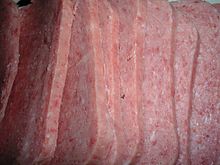
Spam was introduced by Hormel on July 5, 1937.[6] The Oxford Encyclopedia of Food and Drink in America states that the product was intended to increase the sale of pork shoulder which was not a very popular cut.[6]
Ken Daigneau, the brother of a company executive, won a $100 prize that year in a competition to name the new item.[7] Hormel claims that the meaning of the name "is known by only a small circle of former Hormel Foods executives", but a popular belief is that the name is a contraction of "spiced ham".[6][8]
The difficulty of delivering fresh meat to the front during World War II saw Spam become a ubiquitous part of the U.S. soldier's diet. It became variously referred to as "ham that didn't pass its physical", "meatloaf without basic training",[1] and "Special Army Meat". Over 68,000 tonnes (150 million pounds) of Spam were purchased by the military before the war's end.[9]
During World War II and the occupations that followed, Spam was introduced into Guam, Hawaii, Okinawa, the Philippines, and other islands in the Pacific. Immediately absorbed into native diets, it has become a unique part of the history and effects of U.S. influence in the Pacific islands.[10]
As a consequence of World War II rationing and the Lend-Lease Act, Spam also gained prominence in the United Kingdom. British Prime Minister Margaret Thatcher later referred to it as a "wartime delicacy".[11][12]
In addition to increasing production for the U.K., Hormel expanded Spam output as part of Allied aid to the similarly beleaguered Soviet Union.[13] In his memoir Khrushchev Remembers, Nikita Khrushchev declared: "Without Spam we wouldn't have been able to feed our army."[6][14]
Throughout the war, countries ravaged by the conflict and faced with strict food rations came to appreciate Spam.[15]
The billionth can of Spam was sold in 1959,[16] the seven billionth can was sold in 2007,[7] and the eight billionth can was sold in 2012.[17]
International usage[]
United States and territories[]

Domestically, Spam's chief advantages were affordability, accessibility, and extended shelf life.[9] Statistics from the 1990s say that 3.8 cans of Spam were consumed every second in the United States,[18] totaling nearly 122 million cans annually. It became part of the diet of almost 30% of American households, perceived differently in various regions of the country.[19] It is also sometimes associated with economic hardship because of its relatively low cost.[1]
Spam that is sold in North America, South America, and Australia is produced in Austin, Minnesota (also known as "Spam Town USA") and in Dubuque, Iowa.[20] Austin, Minnesota also had a restaurant with a menu devoted exclusively to Spam, called "Johnny's SPAMarama Menu".[21]
Hawaii[]
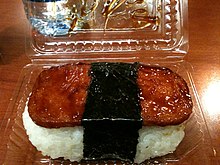
Spam is especially popular in the state of Hawaii, where residents have the highest per capita consumption in the United States. Its perception there is very different from on the mainland.[22] Hawaiians sometimes call it "Portagee Steak".[23]
A popular local dish in Hawaii is Spam musubi, where cooked Spam is placed atop rice and wrapped in a band of nori, a form of onigiri.[24] Varieties of Spam are found in Hawaii and Saipan that are unavailable in other markets, including Honey Spam, Spam with Bacon, and Hot and Spicy Spam.[25]
Hawaiian Burger King restaurants began serving Spam in 2007 to compete with the local McDonald's chains (which also serve Spam).[10][26] In Hawaii, Spam is so popular that it is sometimes referred to as "The Hawaiian Steak".[27] There is even an annual Spam-themed festival on the island of Oahu that takes place every spring, known as the "Waikiki Spam Jam".[28] Local chefs and restaurants compete to create new Spam-themed dishes, which are then sold in a massive street fair on Kalakaua Avenue in Waikiki.
In 2017, Hawaii was plagued by a rash of thefts of Spam.[29] Spam had long been a target of thieves in Hawaii, but the magnitude of the thefts ramped up, with incidents in which multiple cases of Spam were stolen at once. Local retailers believe organized crime was involved.[29] This came alongside increases in thefts of some other retail goods, such as corned beef and liquor. The president of the retail merchants of Hawaii attributed the rise in retail thefts to a recent change in criminal law, which raised the threshold at which a theft would lead to felony charges by approximately $400.[29]
Guam and the Northern Marianas[]
In Guam, average per capita consumption is 16 tins (cans) per year. It is also found on McDonald's menus there. The Spam Games also takes place in Guam, where locals sample and honor the best original, homemade Spam recipes.[30]
In the Northern Mariana Islands, lawyers from Hormel have threatened to sue the local press for publishing articles alleging ill-effects of high Spam consumption on the health of the local population.[31][32]
Puerto Rico[]
Sandwich de Mezcla is a party staple in Puerto Rico containing Spam, Velveeta, and pimientos (made into a spread) between two slices of sandwich bread.[33]
Europe[]
United Kingdom[]
After World War II, Newforge Foods, part of the Fitch Lovell group, was awarded the licence to produce the product in the U.K. at its Gateacre factory, Liverpool,[34] where it stayed until production switched to the Danish Crown Group (owners of the Tulip Food Company) in 1998.[35]
The United Kingdom has adopted Spam into various recipes. For example, recipes include Spam Yorkshire Breakfast, Spamish Omelette, and Spam Hash.[36] Spam can also be sliced, battered and deep-fried into Spam fritters.[37]
Southeast Asia[]
Philippines[]

In the Philippines, Spam (currently distributed by The Purefoods-Hormel Company Inc.) is a popular food item and seen as a cultural symbol. As a former US colony, Spam reached the islands similar to how it reached Hawaii and Guam: as a result of World War II rationing. Spam is commonly eaten with rice (usually garlic fried rice) and a sunny-side up egg for breakfast. It is prepared and used in a variety of ways, including being fried, served alongside condiments, or used in sandwiches. It has also been featured in numerous Filipino fusion cuisine dishes including Spam burgers, Spam spaghetti, Spam nuggets, and others.[39][40][41][42]
The popularity of Spam in the Philippines transcends economic class, and Spam gift sets are even used as homecoming gifts. There are at least ten different varieties of Spam currently available in the country and an estimated 1.25 million kilos of the meat is sold every year in the Philippines.[43] The popularity among Filipinos has led to the creation of a version with sugar and annatto, Tocino-flavor Spam, made for the overseas Filipino market in the US and Canada.[44] During the rescue efforts after Typhoon Ondoy (Ketsana) in 2009, Hormel Foods donated over 30,000 pounds of Spam to the Philippine National Red Cross.[45]
East Asia[]
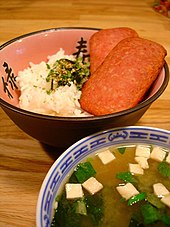
China[]
In mainland China, Hormel decided to adopt a different strategy to market Spam (Chinese: 世棒; pinyin: Shìbàng[46]), promoting it as a foreign, premium food product and changing the Spam formula to be meatier in order to accommodate local Chinese tastes.[47] Spam-like canned pork products are also produced by other food companies in China as "Luncheon Meat" (Chinese: 午餐肉; pinyin: Wǔcānròu; Jyutping: Ng5 caan1 juk6; Zhuyin Fuhao: ㄨˇ ㄘㄢ ㄖㄡˋ).
Hong Kong[]
In Hong Kong after World War II, meat was scarce and expensive, so Spam was an accessible, affordable alternative. The luncheon meat has been incorporated into dishes such as macaroni with fried egg and spam in chicken soup, as well as ramen.[48]
Japan[]
In Okinawa, Japan, the product is added into onigiri alongside eggs and used as a staple ingredient in the traditional Okinawan dish chanpurū, and a Spam burger is sold by local fast food chain Jef. For the 70th anniversary of Spam in 2007, cans with special designs were sold in Japan due to its popularity, primarily in Okinawa.[49] Following the March 2011 earthquake, Spam sales in Japan declined and Hormel shifted its focus to China,[47] although Hormel did pledge to donate $100,000 along with cans of Spam for relief efforts.[50]
In early 2014, Burger King introduced the Spam and Cheese burger as a breakfast menu item.[51]
South Korea[]
Spam was widely consumed within South Korea during the Korean War,[52] and its popularity led to the creation of the Spam kimbap (rice and vegetable filled seaweed roll) in Korean cuisine.[53] Because of a scarcity of fish and other traditional kimbap products such as kimchi or fermented cabbage, Spam was added to a rice roll with kimchi and cucumber and wrapped in seaweed. Spam was also used by US soldiers in South Korea as a means of trading for items, services or information around their bases.[54]
In South Korea, Spam (Korean: 스팸; RR: seupaem, licensed from Hormel by CJ CheilJedang)[55] is popular[56] with a majority of the population.[57] Today, South Korea produces and consumes more Spam than any other country except the United States.[58][59]
Spam is also an original ingredient in budae jjigae (literally "army base stew"), a spicy stew with different types of preserved meat or kimchi etc.[60]
In popular culture[]

Beginning in 1940, Spam sponsored George Burns and Gracie Allen on their radio program.[61]
During World War II, Spam was not only eaten but was also incorporated into many other aspects of the war (grease for guns, cans for scrap metal, etc.); it was so prominent that Uncle Sam was nicknamed "Uncle Spam".[62] Other terms influenced by the product's name include the European invasion fleet, or the "Spam Fleet". Furthermore, the United Service Organizations (USO) toured the "Spam Circuit".[9] In 1943, comedian Suzette Tarri appeared as the harassed waitress character "Mrs Spam" in the British film Somewhere in Civvies.[63]
In the United States in the aftermath of World War II, a troupe of former servicewomen was assembled by Hormel Foods to promote Spam from coast to coast. The group was known as the Hormel Girls and associated the food with being patriotic. In 1948, two years after its formation, the troupe had grown to 60 women with 16 forming an orchestra. The show went on to become a radio program where the main selling point was Spam. The Hormel Girls were disbanded in 1953.[64]
Spam has long had a somewhat dubious reputation in the United States and (to a lesser degree) United Kingdom as a poverty food. The image of Spam as a low cost meat product gave rise to the Scottish colloquial term "Spam valley" to describe certain affluent housing areas where residents appear to be wealthy but in reality may be living at poverty levels.[65]
Spam was featured in an iconic 1970 Monty Python sketch called "Spam".[6] Set in a café which mostly served dishes containing Spam, including "egg and Spam, egg bacon and Spam, Spam egg sausage and Spam, Spam egg Spam Spam bacon and Spam ",[66] the piece also featured a companion song. Because of its use in a line of a song in Monty Python and the Holy Grail, the title of the musical version of the film became Spamalot.
By the 1990s, Spam's perceived ubiquity led to its name being adopted for unsolicited electronic messages, especially spam email.[67]
Spam is the subject of the "Weird Al" Yankovic song "Spam", which is a parody of the R.E.M. song "Stand".[68]
Other offshoots of Spam in popular culture include a book of haikus about Spam titled Spam-Ku: Tranquil Reflections on Luncheon Loaf. There is also a mock Church of Spam, and a Spam Cam which is a webcam trained on a can of decaying Spam.[69]
Spam is referred to in Island of the Sequined Love Nun by Christopher Moore, where SPAM is explained as Shaped Pork Approximating Man, which was used to explain its popularity amongst Pacific Island Cannibals.[70]
The Pumpkin Spice flavour, introduced in September 2019, has gained the attention of the media and public.[71]
Spam celebrations[]

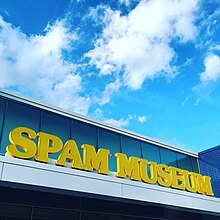
Spam is celebrated in Austin, Minnesota, home to the Spam Museum. The museum tells the history of the Hormel company, the origin of Spam, and its place in world culture.
Austin is also the location of final judging in the national Spam recipe competition. Competing recipes are collected from winning submissions at the top 40 state fairs in the nation. The Spamettes are a quartet from Austin who only sing about Spam in parodies of popular songs. They first performed at the first Spam Jam in 1990 and continue to perform at various events.[72]
Hawaii holds an annual Spam Jam in Waikiki during the last week of April.[73] The small town of Shady Cove, Oregon is home to the annual Spam Parade and Festival, with the city allocating US$1,500 for it.[74]
Spamarama was a yearly festival from 1978 to 2007 in Austin, Texas which had a peak attendance of 14,000. The themed events included a Spam cook-off (to contrast with Texas chili cook-offs) and the Spamalymplics including a "Spam toss" and a Spamburger (a 12-ounce portion on a bun) eating contest. The event returned in 2019.[75]
Nutritional data[]
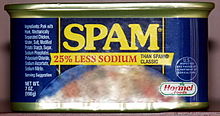

The ingredients of Spam vary according to variety and market; those of variety "Spam Classic" are: pork, ham, salt, water, potato starch, sugar, and sodium nitrite.[76][77]
|
Net weight per package: 340 grams (12 oz.) Serving size: 100g | |
| Quantity per 100g | |
|---|---|
| Energy | 1,300 kJ (310 Calories or kilocalories) |
| Protein | 13g (26% Daily Value or DV) |
| Total Fat | 27g (41% DV) |
| – saturated fat | 10g (49% DV) |
| Carbohydrates | 3g (1% DV) |
| Sodium | 1369 mg (57% DV) |
| Cholesterol | 70 mg (23% DV) |
| Vitamins and Minerals (% DV) | 1% Vitamin C, 1% Calcium, 5% Iron,
3% Magnesium, 9% Potassium, 12% Zinc, and 5% Copper |
Varieties[]
As listed on the official Spam website, there are numerous different flavors of Spam products, including:
- Spam Classic – original flavor
- Spam Hot & Spicy – with Tabasco flavor
- Jalapeño Spam
- Spam with Black Pepper
- Spam Low Sodium – "25% less sodium"
- Spam Lite – "33% fewer calories, 25% less sodium, and 50% less fat" – made from pork with ham, and mechanically separated chicken
- Spam Oven Roasted Turkey
- Spam Hickory Smoked
- Spam Spread – "if you're a spreader, not a slicer ... just like Spam Classic, but in a spreadable form"
- Spam Bacon
- Spam Cheese
- Spam Garlic
- Spam Teriyaki
- Spam Chorizo
- Spam Boricua – seasoned Puerto Rican-style flavor
- Spam Macadamia Nuts – Partnered with Hamakua Plantation
- Spam Turkey
- Spam Tocino
- Spam Portuguese Sausage
- Spam Pumpkin Spice - limited edition variety released in late September 2019
- In addition to the variety of flavors, Spam is sold in tins smaller than the twelve-ounce standard size. Spam Singles are also available, which are single sandwich-sized slices of Spam Classic or Lite, sealed in retort pouches.[79]
See also[]
- Spam (Monty Python) – Monty Python sketch - Humour and Song
- Treet
- Prem
- Back bacon – Type of bacon
- Bologna sausage – Finely ground pork sausage
- Corned beef – Salt-cured beef product
- Loco moco – a Hawaiian dish that uses Spam in some versions
- Pork roll
- Potted meat food product
- Tushonka – Soviet canned meat product – a canned, stewed meat
References[]
- ^ Jump up to: a b c Martin, Andrew (November 15, 2008). "Spam Turns Serious and Hormel Turns Out More". The New York Times. Archived from the original on April 20, 2011. Retrieved May 23, 2010.
- ^ "Spam – Postwar Popularity". Hormel Foods. 2010. Archived from the original on December 15, 2007.
- ^ Campbell, Belinda; Clapton, Barbara; Tipton, Catherine (2002). Food Technology. Heinemann. p. 20.
- ^ "Archived copy". Archived from the original on July 23, 2018. Retrieved July 23, 2018.CS1 maint: archived copy as title (link)
- ^ "RFC 2635 – DON'T SPEW A Set of Guidelines for Mass Unsolicited Mailings and Postings (spam*)". Archived from the original on August 1, 2010. Retrieved September 29, 2010.
- ^ Jump up to: a b c d e Waxman, Olivia B. (July 5, 2017). "Spam Turns 80: History and Origins of Canned Meat". Time.com. Archived from the original on February 11, 2018. Retrieved October 30, 2017.
- ^ Jump up to: a b "Spam Brand History". Spam. Archived from the original on November 27, 2016. Retrieved November 27, 2016.
- ^ "What does the SPAM brand name mean?", SPAM Brand FAQ, Spam, archived from the original on November 27, 2016, retrieved October 22, 2009
- ^ Jump up to: a b c Smith, Andrew (May 1, 2007). The Oxford Companion to American Food and Drink. Oxford University Press. pp. 559–60. ISBN 978-0-19988576-3. Archived from the original on January 9, 2020. Retrieved January 8, 2016.
- ^ Jump up to: a b "Burger King to Serve Spam in Hawaii". Yahoo! News. Archived from the original on June 13, 2007. Retrieved July 5, 2013.
- ^ Howard Yoon (July 4, 2007). "Spam: More than Junk Mail or Junk Meat" (npr.org). Archived from the original on August 23, 2018. Retrieved April 5, 2018.
- ^ Stranska, Hana (July 24, 1994). "About Spam". The New York Times. Archived from the original on October 6, 2014. Retrieved October 1, 2014.
- ^ Atkins, Annette (2007). Creating Minnesota: A History From the Inside Out. Minnesota: Minnesota Historical Society. p. 194. ISBN 978-0-87351-633-4. Archived from the original on May 24, 2021. Retrieved December 13, 2010.
- ^ Smith, Andrew F., ed. (2012). The Oxford Encyclopaedia of Food and Drink in America. Oxford University Press. p. 343. ISBN 978-0199734962.
- ^ Heydt, Bruce. "Spam Again" . America in WWII, June 2006.
- ^ Waxman, Olivia B. (July 5, 2017), "Spam Is Turning 80. Here's How the Canned Meat Took Over the World", time.com, archived from the original on February 11, 2018, retrieved March 13, 2018
- ^ Jackson, Sharyn (July 5, 2017), "For Spam's 80th anniversary, 10 outrageous retro recipes by the Minnesota meat maker", startribune.com, archived from the original on March 14, 2018, retrieved March 13, 2018
- ^ "Data Stream". Next Generation. No. 25. Imagine Media. January 1997. p. 28.
- ^ Kim, Sojin; Livengood, Mark (1995). "Ramen Noodles and Spam: Popular Foods, Significant Tastes" Archived October 6, 2014, at the Wayback Machine, pp. 2–11. Retrieved September 18, 2014.
- ^ Wyman, Carolyn. "Spam: A Biography." Harvest Books, 1999
- ^ "Spam Turns Serious and Hormel Turns Out More". The New York Times. November 14, 2008. Archived from the original on June 15, 2013. Retrieved July 5, 2013.
- ^ Lovegren, Sylvia (2005). Fashionable food: seven decades of food fads. United States: University of Chicago Press. p. 190. ISBN 978-0-226-49407-4. Archived from the original on May 24, 2021. Retrieved December 13, 2010.
- ^ Corum, Ann Kondo (1987). Hawaii's Spam Cookbook. United States: Bess Press. p. 135. ISBN 0935848495. Archived from the original on May 24, 2021. Retrieved June 4, 2018.
- ^ "Spam – Hawaiian Spam Musubi". Whatscookingamerica.net. Archived from the original on June 19, 2013. Retrieved July 5, 2013.
- ^ Song, Jaymes (June 11, 2007). "Burger giants wage Spam war". The Star. Toronto. Archived from the original on January 27, 2020. Retrieved January 27, 2020.
- ^ Huppert, Boyd (May 17, 2007). "Land of 10,000 Stories – Spam in Paradise". KARE11 News. Archived from the original on June 5, 2012.
- ^ "The Spam That Isn't Via E-Mail". The New York Times. April 7, 2003. Archived from the original on May 24, 2021. Retrieved December 28, 2007.
- ^ "Welcome - Waikiki Spam Jam". Welcome. Archived from the original on June 15, 2017. Retrieved June 14, 2017.
- ^ Jump up to: a b c Singh, Lakshmi (October 22, 2017). "Hawaii's Spate Of Spam Heists". NPR. Archived from the original on October 23, 2017. Retrieved October 23, 2017.
- ^ "Why is Spam Brand a Household Name?". Archived from the original on October 10, 2014. Retrieved October 6, 2014.
- ^ "Organic smoke (and mirrors)". Saipan Tribune. July 21, 2006. Archived from the original on June 23, 2008. Retrieved June 21, 2009.
- ^ "A junkie waiting to happen". Saipan Tribune. July 14, 2006. Archived from the original on June 23, 2008. Retrieved June 21, 2009.
- ^ "Receta: Sandwichitos para fiestas". August 12, 2013. Archived from the original on October 7, 2014. Retrieved October 6, 2014.
- ^ The story of Fitch Lovell Ambrose Keevil Phillimore Press 1972 ISBN 978-0-85033-074-8
- ^ "Tulip Food Company". english.tulip.dk. Archived from the original on August 14, 2009. Retrieved June 21, 2009.
- ^ "Spam—UK". Archived from the original on October 10, 2014. Retrieved October 6, 2014.
- ^ "Spam Fritters" (PDF). Archived from the original (PDF) on October 10, 2014. Retrieved October 6, 2014.
- ^ Casey, Nell (December 16, 2016). "Stay Warm With Filipino Brunch & A Cookie Competition This Weekend". Gothamist. WNYC. Archived from the original on February 24, 2018. Retrieved January 20, 2019.
- ^ Escalona, Katrina (September 18, 2017). "Why Spam and Rice is a Filipino Food Classic". Culture Trip. Archived from the original on January 20, 2019. Retrieved January 20, 2019.
- ^ Ke, Bryan (December 12, 2017). "Why Filipinos Love Spam So Much". NextShark. Archived from the original on January 20, 2019. Retrieved January 20, 2019.
- ^ Agoncillo, Anna (September 29, 2016). "What Is SPAM And Why Are Filipinos Obsessed With It?". RemitBlog. Archived from the original on January 20, 2019. Retrieved January 20, 2019.
- ^ Ong, Sherina (June 24, 2014). "SPAM: A story of love and hate". Rappler. Archived from the original on January 20, 2019. Retrieved January 20, 2019.
- ^ Matejowsky, Ty (March 1, 2007). "SPAM and Fast-food "Glocalization" in the Philippines". Food, Culture and Society. 10 (1): 23–41. doi:10.2752/155280107780154088. S2CID 168108901.
- ^ "Archived copy". Archived from the original on October 19, 2020. Retrieved September 15, 2020.CS1 maint: archived copy as title (link)
- ^ "Hormel Foods Announces Donation to Philippines". Web wire. October 8, 2009. Archived from the original on March 22, 2012. Retrieved September 24, 2010.
- ^ "一朝种草,三年拔。SPAM世棒又...双...叒回来了!!!". Sohu. December 22, 2017. Archived from the original on July 14, 2020. Retrieved July 14, 2020.
- ^ Jump up to: a b "Spam's Long March in China". Bloomberg BusinessWeek. August 4, 2011. Archived from the original on August 24, 2014. Retrieved October 6, 2014.
- ^ "Why is Spam served in Hong Kong diners on top of macaroni noodles?". HK Magazine. Archived from the original on October 10, 2014. Retrieved October 6, 2014.
- ^ Sieg, Linda (March 12, 2008). "Okinawa cuisine: tofu, Spam and root beer". Reuters. Archived from the original on May 24, 2021. Retrieved September 24, 2010.
- ^ "Hormel Foods Pledges to Relief Efforts in Japan". Reuters. March 17, 2011. Archived from the original on October 10, 2014. Retrieved October 6, 2014.
- ^ Bleier, Evan (May 1, 2014). "Burger King introduces Spam and cheese burger in Japan, for breakfast". United Press International. Archived from the original on October 10, 2014. Retrieved October 6, 2014.
- ^ Oh, Hye-In; Choi, Eun-Kyoung; Jeon, Eun-Yeoung; Cho, Mi-Sook; Oh, Ji-Eun (2019). "An Exploratory Research for Reduction of Sodium of Korean HMR Product -Analysis on Labeling of Guk, Tang, Jjigae HMR Products in Korea-". The Journal of the Korea Contents Association. 19 (3): 510–519. doi:10.5392/JKCA.2019.19.03.510. ISSN 1598-4877.
- ^ 오혜인; 최은경; 전은영; 조미숙; 오지은 (March 2019). "국내 HMR제품의 나트륨 저감화를 위한 탐색적 분석 :국내 국, 탕, 찌개류 HMR제품의 라벨 분석을 중심으로". 한국콘텐츠학회논문지 (in Korean). Retrieved April 4, 2021.
- ^ "In Korea, It's Spam Time of Year". Archived from the original on December 1, 2017. Retrieved August 4, 2017.
- ^ "스팸 (SPAM)". CJ CheilJedang. Archived from the original on November 2, 2016. Retrieved November 14, 2016.
- ^ Hong, Hee-Ok; Kim, Jung-Yoon; Lee, Jung-Sug (2006). "Survey on Korean Food Preference of College Students in Seoul - Focused on Side Dishes -". Journal of Nutrition and Health. 39 (7): 707–713. ISSN 2288-3886.
- ^ Kim, Hye-Young L.; Kang, Nam-E. (2005). "A Survey on the Seasonal Menu and Consumer Acceptance Test of Free Meals for the Elderly Facility in Sungnam Region". Journal of the Korean Society of Food Culture. 20 (2): 273–282. ISSN 1225-7060. Archived from the original on February 26, 2021. Retrieved April 4, 2021.
- ^ Lewis, George H. (2004). "From Minnesota Fat to Seoul Food: Spam in America and the Pacific Rim". The Journal of Popular Culture, volume 34, issue 2., [1][permanent dead link]
- ^ "In South Korea, Spam Is the Stuff Gifts Are Made Of". The New York Times. January 26, 2014. Archived from the original on July 15, 2017. Retrieved February 18, 2017.>
- ^ Walraven, Boudewijn; Breuker, Remco E. (2007). Korea in the middle: Korean studies and area studies : essays in honour of Boudewijn Walraven. Leiden: CNWS Publications. pp. 255–257. ISBN 978-90-5789-153-3. Archived from the original on May 24, 2021. Retrieved December 13, 2010.
- ^ Brown, Ray Broadus (2001). The Guide to United States Popular Culture. University of Wisconsin Press. p. 762. ISBN 9780879728212. Archived from the original on May 24, 2021. Retrieved November 21, 2020.
- ^ Civitello, Linda (March 29, 2011). Cuisine and Culture: A History of Food and People. John Wiley & Sons. p. 347. ISBN 9780470403716. Archived from the original on August 19, 2020. Retrieved January 8, 2016.
- ^ "Somewhere in Civvies, BFI Archived October 26, 2020, at the Wayback Machine. Retrieved 21 October 2020
- ^ Danelle D. Keck, Jill M. Sullivan (2007). "The Hormel Girls, American Music, Vol. 25, No. 3 (Fall, 2007), pp. 282–311". University of Illinois Press. JSTOR 40071663.
- ^ Hardill, Irene; Graham, David; Kofman, Eleonore (2001). Human geography of the UK: an introduction. London: Routledge. pp. 96–97. ISBN 978-0-415-21426-1. Archived from the original on May 24, 2021. Retrieved December 13, 2010.
- ^ "Spam". Monty Python. Archived from the original on November 9, 2017. Retrieved October 30, 2017.
- ^ "Merriam Webster Dictionary". Merriam-Webster. Archived from the original on March 23, 2019. Retrieved April 23, 2014.
- ^ "WEIRD AL YANKOVIC – SPAM LYRICS". Archived from the original on April 2, 2015. Retrieved August 3, 2014.
- ^ Smith, Andrew F. (May 2007). The Oxford Companion to American Food and Drink. ISBN 9780199885763. Archived from the original on January 9, 2020. Retrieved October 6, 2014.
- ^ "The magical, mystical world of SPAM - AOL Finance". Aol.com. December 29, 2008. Archived from the original on October 15, 2016. Retrieved October 30, 2017.
- ^ Bomey, Nathan. "Pumpkin spice version of Spam?! Hormel Foods introduces limited-edition Spam". USA TODAY. Archived from the original on September 26, 2019. Retrieved September 26, 2019.
- ^ "Singing Spam's praises". July 7, 2008. Archived from the original on April 10, 2016. Retrieved October 6, 2014.
- ^ Hormel Foods (2010). "Spam Jam Waikiki 2010". Hormel Foods Corporation. Archived from the original on February 9, 2011. Retrieved December 13, 2010.
- ^ Pitto, Christy (December 7, 2010). "Shady Cove issues- riparian, event insurance and liability". Upper Rogue Independent. Archived from the original on July 17, 2011. Retrieved December 13, 2010.
- ^ Currie-Buckner, Alexandra (July 4, 2019), "Festival Founder Resurrects Spamarama After 12-Year Hiatus", Austin Chronicle, archived from the original on May 24, 2020, retrieved May 5, 2020
- ^ Lee, Yun-Ju; Jang, Gyeong-Ja (1998). "Preliminary Study on the Establishment of Proper Portion Using Consumed Size and Food Preference of Frequently Served Meals in the Elementary School Lunch Program in Inchon - 2 . A Study on the Consumption Size of Frequently Served Meals in the Eleme". Journal of the Korean Dietetic Association. 4 (2): 132–144. ISSN 1225-9861. Archived from the original on May 24, 2021. Retrieved April 4, 2021.
- ^ "What is Spam Classic?". Spam.com. Hormel Foods. Archived from the original on June 17, 2015. Retrieved September 18, 2014.
- ^ "Nutritional Facts and Analysis for Spam". Nutritiondata.com. Archived from the original on May 24, 2008. Retrieved July 5, 2013.
- ^ "SPAM Products". Store.spam.com. Retrieved July 5, 2013.[permanent dead link]
External links[]
| Wikimedia Commons has media related to Spam (food). |
| Look up spam in Wiktionary, the free dictionary. |
- Official website – United States
- Collection of mid-twentieth century advertising featuring Spam from The TJS Labs Gallery of Graphic Design.
- Spam (food)
- Brand name meats
- Hawaiian cuisine
- Hormel brands
- Pork
- Products introduced in 1937
- Food and drink introduced in the 1930s